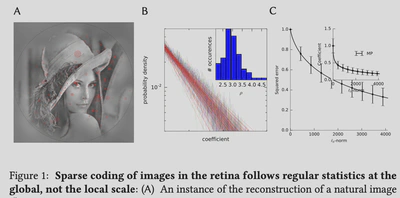Differential response of the retinal neural code with respect to the sparseness of natural images

Type

How does the retina respond to stimuli with different sparseness?
This stimulus is generated simply using the Motion Clouds library by defining a sparse draw of events:
import numpy as np
import MotionClouds as mc
import matplotlib.pyplot as plt
# PARAMETERS
seed = 2042
np.random.seed(seed=seed)
N_sparse = 5
sparse_base = 2.e5
sparseness = np.logspace(-1, 0, N_sparse, base=sparse_base, endpoint=True)
print(sparseness)
# TEXTON
N_X, N_Y, N_frame = 256, 256, 1
fx, fy, ft = mc.get_grids(N_X, N_Y, 1)
mc_i = mc.envelope_gabor(fx, fy, ft, sf_0=0.05, B_sf=0.025, B_theta=np.inf)
values = np.random.randn(N_X, N_Y, N_frame)
chance = np.argsort(-np.abs(values.ravel()))
chance = np.array(chance, dtype=np.float)
chance /= chance.max()
chance = chance.reshape((N_X, N_Y, N_frame))
fig, axs = plt.subplots(1, N_sparse, figsize=(fig_width, fig_width/N_sparse))
for i_ax, l0_norm in enumerate(sparseness):
threshold = 1 - l0_norm
mask = np.zeros_like(chance)
mask[chance > threshold] = 1.
im = 2*mc.rectif(mc.random_cloud(mc_i, events=mask*values))-1
axs[i_ax].imshow(im[:, :, 0], vmin=-1, vmax=1, cmap=plt.gray())
#axs[i_ax].text(9, 80, r'$n=%.0f\%%$' % (noise*100), color='white', fontsize=10)
axs[i_ax].text(4, 40, r'$\epsilon=%.0e$' % l0_norm, color='white', fontsize=8)
axs[i_ax].set_xticks([])
axs[i_ax].set_yticks([])
plt.tight_layout()
fig.subplots_adjust(hspace = .0, wspace = .0, left=0.0, bottom=0., right=1., top=1.)